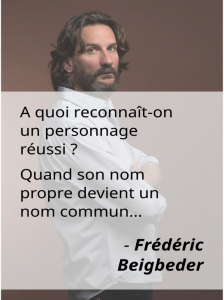Proper nouns in French
Les noms propres
Salut, and welcome to our lesson about proper nouns in French, at Language Easy! Proper nouns are not a central concept in French grammar, but there are still some useful things to learn there. We will guide you through.
Allez, on y va !
About proper nouns in French
À propos des noms propres en français
In French, Proper nouns, are words that name people, things or places in a specific way, differentiating them from the rest of their kind as a particular individual.
They start by a capital letter, and don’t usually need to be accompanied by a determiner.
In other words, proper nouns in French are the grammatical mark of the name of someone or something.
To each proper noun can be associated common names describing the kind to which that particular individual belongs :
- Jack Sparrow (proper noun) est un pirate (pirate, common name)
- L’Inde (proper noun) est un pays (country, common noun)
- Ganesha (proper noun) est un dieu (god, common noun) indien
Use of proper nouns in French
L’usage des noms propres en français
A proper noun can describe anything :
- something real (le fleuve Mississipi) as well as something from fantasy (Le monde de Narnia)
- something concrete (Le roi Salomon) as well as something abstract (Dieu)
- something artificial (Times Square) as well as something natural (L’Himalaya)
The way we name things is arbitrary, and names can originate from common nouns (or any other category of words) as well. Historically, people’s or place’s names often originated from one of their characteristic, like in the case of the mountain le Mont Blanc (the white mount) or of the French actor Jean Dujardin (lit. Jean from the garden).
Most of the time, it is pretty obvious that nouns are proper nouns and not common nouns, because we are used to hear them as names (Napoléon, William). Sometimes, it’s the the context that makes it obvious : J’ai appelé mon chien Ventre. (I named my dog “Stomach”).
In some cases, it can be a bit tricky to tell if a word names or qualifies something :
- Le Malade imaginaire (proper noun, the name of Molière’s play) VS Le malade imaginaire (common name, an imaginary ill person)
- les français (the ones that are from France) VS les Français (name of the category of French people)
- La Rue de la paix à Paris, but never la rue de la paix à Paris
In practice, there is no limit to naming things. Anyone is free to name his or her kitchen table “Gertrude” or “La table”.
- Peux-tu me passer ma tasse, s’il te plaît ? Elle est sur La table.
Can you pass me my cup please ? it’s on The table.
Here the capitalization indicates clearly that The table is the name of something (which can be something else than a table, by the way, depending on the intention of the giver of the name) and not a common name naming an object (a table).
This process is called personification and is used a lot in poetry and literature (in a less mundane way generally) :
Un soir, j’ai assis la Beauté sur mes genoux.
Et je l’ai trouvée amère.
Et je l’ai injuriée.
– Arthur Rimbaud
How to write the proper nouns in French
Comment écrire les noms propres en français
As a rule, all proper nouns begin with a capital letter.
But if the name takes the form of a nominal locution (which is a noun composed of various words), what about the other words ?
If the main word is first in the locution, then it’s the only one to have a capital letter (except of course if the locution contains another proper noun) :
- l’Académie française
- la Rue de la paix
- la République du Congo
If there are words in the locution that are placed before it, then their first letter is also capitalized :
- Le Moyen Âge
If the words of the locution are connected by hyphens, then all the words get their first letter capitalized, except the tool-words (mots-outils), like the conjunctions and articles :
- L’Arc-de-Triomphe
When to use proper nouns in French
Quand utiliser les noms propres en français
Always use a proper nouns with names of animate beings like persons, animals, divinities, supernatural or mystical beings.
- Napoléon, Médor, Bouddha, Superman, le Kraken
Always use a proper nouns with names of geographical places, whether they are natural (continents, regions, mountains, forests, oceans, lakes, rivers…) or artificial (countries, cities, administrative regions, squares, avenues, streets…).
- la France, la Méditerranée, la Forêt noire, la Rue de la paix, Times square
As for the geography of the universe outside planet Earth, the usage is there, but the rule is less strict :
- la Terre, le soleil, la lune, Jupiter, la voie lactée / la Voie lactée.
Always use a proper nouns with names of pieces of art :
- De Vinci’s Joconde
- Delacroix’s Liberté guidant le peuple
Names of brief and unique historical events or periods are often proper nouns in French :
- La Révolution française de 1789, l’Occupation (allemande), le Cétacé, Noël, Pâques
An interesting usage of proper nouns is to use them generically as if they were a category in themselves, although they usually refer to a unique individual, when we want to talk about a famous aspect or quality of this person. For example :
- On recherche un Hulk pour déplacer ce meuble lourd.
We’re looking for a Hulk to move that heavy piece of furniture.
Note that if a geographical region is used as a name for its local specialty, like the camembert (cheese from Camembert) or the bordeaux (wine from Bordeaux), then it becomes a product name and a common noun must be used. In some cases, that name is also a patented brand name, and we can also choose to name the brand instead of the product (and use a capital letter).
- un camembert
- un bordeaux / un Bordeaux
Use of an article before proper nouns
Usage d’un article avec les noms propres
Unlike with common nouns, we don’t need to use article with proper nouns in French because their gender is already included in their definition. In some cases, though, such an article is used ; let’s present a few of these cases.
Geographical entities are always introduced by an article :
- Le Mont Blanc
- le Danube
- l’Avenue des Champs-Élysées
Categories or groups of people or objects (like nationalities, teams, brands) are always introduced by an article :
- Les Français, les Écossais (scottish people)
- Les Bleus (the national French Football team)
- une Ferrari (a Ferrari), un Bordeaux (a [bottle of] Bordeaux)
Monuments, objects or beings named after a common noun are usually introduced by an article :
- Les Pyramides
- L’Orient-Expressrac
- Le Croque-mitaines
We can refer to family members as a group using their surname with an article :
- Les Martin sont une famile très sympathique. (The Martin family members form a very sympathetic family).
- Les Dutertre ont tous les yeux bleus. (The Dutertre all have blue eyes).
- Il y avait au moins un Chirac à la fête hier. (There was at least one Chirac at the party yesterday).
A definite article can be used as an exceptional emphasis :
- “Le” Neymar ? Le joueur de foot ? (“The” Neymar ? the football player ?)
An article can be used with a proper noun that usually doesn’t require one to refer to a particular mood or aspect of someone or something :
- Le David d’avant était plus sympathique. (The David of before was nicer = David was nicer before)
- Le Hulk vert es très fort. (Green Hulk is very strong, as opposed to when he is not green).
- J’ai vu un Paris très calme ce jour là. (I saw a very calm Paris on that day)
In the past, there was some usage to use definite articles with people’s names. You might hear something like this in some old French movie :
- Tu as vu le Marcel ? (Did you see Marcel)
- Dis à la Fernande d’aller au puits me chercher de l’eau ! (Tell Fernande to get water from the well for me)
Plural of proper nouns in French
Le pluriel des noms propres en français
Proper names in French are invariable, they don’t take an “s” in the plural.
- Des Picasso (arts by Picasso)
- Les Macron (the members of the Macron family)
There are though a few exceptions :
- Royal family members in French : les Bourbons. Les Capets. Les Stuarts, etc.
- Proper nouns used generically as a common noun : Ce sont des Ulysses (they are Ulysses = they are very strong)
- Geographical places grouped by the same name : les Guyanes, Les Amériques
Also note the difference between the use of a brand name and of a product name :
- des Ferrari (brand name = proper noun, invariable)
- des ferraris (product name = common noun, variable)
Gender of proper nouns in French
Le genre des noms propres en français
Proper nouns are nouns, and as such they have a gender – they are either masculine or feminine.
When the referred object is an animate being, the gender of the proper noun is its natural gender :
- Marc est grand.
Marc (m) is tall. - Claire est grande.
Claire (f) is tall.
Note that the gender is deduced from the definition of the referred object itself, not from its name. In other words, Marc is not masculine because of the grammar, but because the person referred as Marc is a man. Of course, generally, all Marcs are women, but there are some names like Dominique or Claude that can be given to both men and women.
When the proper noun is used with an article, this article will tell the gender :
- La Loire (The river Loire, f)
- Le Rhin (The river Rhin, m)
In any other cases, the gender is generally inherited from the generic category to which the referred object belongs.
- Berlin (une ville, f) est belle.
Berlin (a city) is lovely. - Saturne (une planète, f) est belle avec ses anneaux.
Saturne (a planet) is pretty with its rings.
About firstnames and surnames in France
À propos des noms et des prénoms en France
Unlike some other countries, In France, people usually inherit only their father’s surname ; but if the parents wish so, the mother’s last-name can be transmitted instead, or both. This is called le nom de famille (the family name), or simply le nom (the name).
Also, people generally give 2 to 3 first-names to their children, although he will use only the first one throughout his life. We call these le prénom (first-name), le deuxième prénom (second first-name) and le troisième prénom (third first-name). They usually are symbolic references to important persons in the parent’s life to whom they want to give homage. For example, I received as third first-name Bruno, in souvenir of my grandmother Bruna, who died soon after my birth. Interesting fact : It also happens that the gender of the secondary first-names is different from the person’s gender.
To sum it up, here’s an example of what could actually appear on someone’s ID card :
Julien Marc Marie Dutertre-Garance
Julien : pénom
Marc : deuxième prénom
Marie : troisième prénom
Duterte : nom du père
Garance : nom de la mère
Did you know ?
Le saviez-vous ?
The name of people originate from the common language, and became proper nouns only by usage. Inheritance of name in a family lineage hasn’t always been the usage, and started to appear as civilization progressed, from a need to recognize oneself as member of a group for the transmission of riches from one generation to the other. Only since 1539 and the creation of the Civil registry, events like birth, weddings and death started being recorded by law, and names acquired fixity for each individual. A royal ordinance from 1955 prohibited to change one’s name without the approval of the Prince.
What’s next?
C’est quoi, la suite ?
Et voilà, we reached the end of our lessons about proper names in French. Good news, there were a few classic mistakes that you won’t do any more ! To continue in your study of French, how about starting to learn about French verbs ?
Allez, à bientôt !



